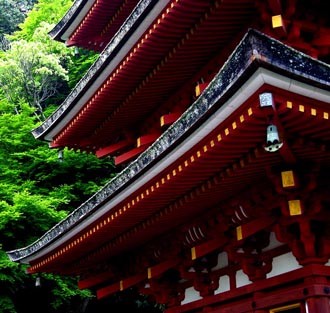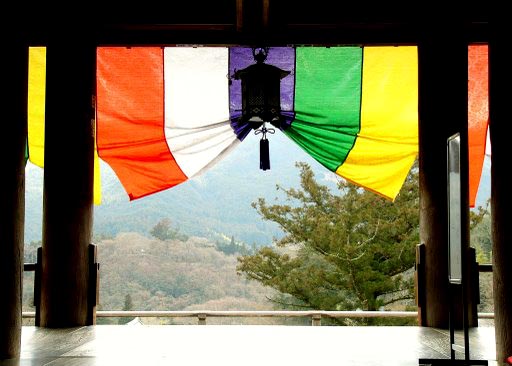
長谷寺 (Hase-dera) – Temple of Flowers and Miracles
Overview
Hase-dera, formally known as 豊山神楽院長谷寺 (Buzan Kagura-in Hase-dera), is the head temple of the Shingon Buzan sect and the 8th temple of the Saigoku 33 Kannon pilgrimage. Founded in the late 7th century, it stands on Mt. Hakurai in Nara Prefecture and draws pilgrims year-round as “The Temple of Flowers,” renowned for peonies, cherry blossoms, and vivid autumn leaves.

Historical Background
In 686, the ascetic priest Dōmyō Shōnin enshrined Emperor Tenmu’s bronze Lotus Sutra relief on the western hill. Later, in 727, Tokudō Shōnin carved a monumental Eleven-headed Kannon from a sacred camphor log that had drifted from Lake Biwa. Tokudō is revered as the founder of the Saigoku pilgrimage, making Hase-dera the root temple of the circuit.
Through the centuries, Hase-dera has been destroyed by fire and rebuilt multiple times. Literary works by Sei Shōnagon and Murasaki Shikibu attest to its prominence in the Heian era, when noblewomen braved arduous journeys to worship here.
Legends
The Sacred Camphor Tree
A massive driftwood camphor log brought misfortune to those who tried to cut or move it—until Tokudō Shōnin prayed before it for years, eventually carving it into the great Kannon. The statue was placed atop a boulder revealed to him in a dream, becoming the heart of the temple.

The Man with the Straw Bundle
A destitute samurai prayed for aid, vowing to die at the temple if his fate did not change. On the 21st day, a dream guided him to take whatever he touched upon leaving—he stumbled and picked up a piece of straw. Through a series of trades and acts of kindness, the straw led to wealth, thanks to Kannon’s unseen hand.
The “Future Bell”
A poor man named Noji promised a fine temple bell if ever blessed with prosperity. Years later, elevated to high office, he fulfilled his vow in 1019. The bell, inscribed “Future Man,” rang daily to remind all of Kannon’s compassion.
The Healing Crow
When the son of a Shinto priest fell gravely ill, a crow snatched a sacred sakaki leaf offered at Hase-dera, then drew a venomous snake from the boy’s wound—curing him instantly.
Principal Image of Worship
Hase Kannon (十一面観音)
Standing 10 meters tall, the Hase Kannon is Japan’s largest wooden Eleven-headed Kannon, carved from camphor wood. Rebuilt in 1538 after fire, it retains the original 8th-century head. Kannon holds a vase and lotus in one hand, Jizō’s staff in the other—symbolizing boundless compassion and the ability to aid any being. Surrounding heads display varied expressions—anger, laughter, fangs—each dispelling a different human delusion:contentReference[oaicite:0]{index=0}.
Flanking the Kannon are:
- Uhō Dōji (雨宝童子) – Wish-granting youth, carved 1538, 116 cm tall.
- Nandaryū-ō (難陀龍王) – Dragon King guardian, carved 1316, with a dragon rising above his head.
All three are National Important Cultural Properties.
Places of Interest
Monzen-machi
A bustling street of inns, tea houses, souvenir shops, and food stalls leading to the temple, evoking the pilgrimage atmosphere of centuries past.
Niōmon
1885 main gate, with guardian statues pronouncing “Ah” and “Hum,” the first and last Sanskrit letters.
Noborirō
A covered stairway of 399 steps (plus 3 to the Hondō) symbolically overcoming death. Lined with lanterns and thousands of peonies.
Hondō & Maidan
Built 1650 to house the great Kannon, with a vast nail-less platform extending over the valley, offering views of the mountain sacred to Amaterasu.

Other Highlights
- Shuhō-zō – Treasure hall with Buddhist art and samurai arms.
- Tengu Sugi – “Flying Squirrel Cedar,” tied to a novice monk’s memories.
- Zaō Gongen-dō – Shugendō mountain deity shrine.
- Onoe-no-Kane – The “Future Bell.”
- Mizuko Jizō – Figures honoring lost pregnancies.
- Moto Hasedera – Site of the original temple.
- Gojū-no-tō – Five-story pagoda, rebuilt 1954.
- Shakyōdō – Hexagonal sutra storehouse.
Goeika
Ikutabi mo
Mairu kokoro wa
Hatsusedera
Yama mo chikai mo
Fukaki tanigawaCome again and again
With your pilgrim’s heart
To Hasedera
Where the mountains and the vows
Are as deep as the river valley


